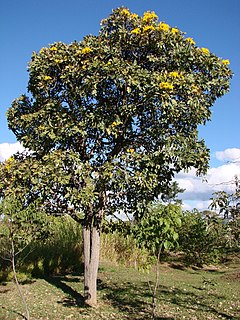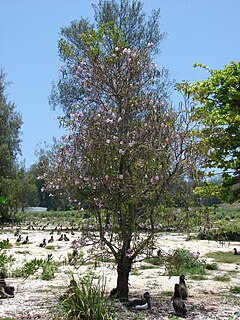
Tabebuia is a genus of flowering plants in the family Bignoniaceae. The common name "roble" is sometimes found in English. Tabebuias have been called "trumpet trees", but this name is usually applied to other trees and has become a source of confusion and misidentification.

Bignoniaceae is a family of flowering plants in the order Lamiales commonly known as the bignonias. It is not known to which of the other families in the order it is most closely related.

Handroanthus serratifolius is a species of tree, commonly known as yellow lapacho, pau d'arco, yellow poui, yellow ipe, pau d'arco amarelo, or ipê-amarelo.

Tabebuia roseo-alba, known as white ipê, ipê-branco or lapacho blanco, is a tree native to Cerrado and Pantanal vegetation in Brazil, but also appears in Argentina and more rarely in Paraguay.

Tabebuia cassinoides is a tree native to Central and South America. It is used as a timber tree to make pencils.

Eugenia haematocarpa is a rare species of plant in the family Myrtaceae. It is endemic to Puerto Rico. It is classified as an endangered species by the U.S. Fish and Wildlife Service and there has been a plan for its recovery in place for some years. Its common names include uvillo and Luquillo Mountain stopper.
Tabebuia bibracteolata is a species of plant in the family Bignoniaceae. It is endemic to Cuba.
Tabebuia dubia is a species of plant in the family Bignoniaceae. It is endemic to Cuba. It is threatened by habitat loss.

Tabebuia hypoleuca is a species of plant in the family Bignoniaceae. It is endemic to Cuba.
Tabebuia platyantha is a species of plant in the Bignoniaceae family. It is endemic to Jamaica.
Tabebuia shaferi is a species of plant in the family Bignoniaceae. It is endemic to Cuba. It is threatened by habitat loss.

Tabebuia aurea is a species of Tabebuia native to South America in Suriname, Brazil, eastern Bolivia, Peru, Paraguay, and northern Argentina. The common English name Caribbean trumpet tree is misleading, as it is not native to the Caribbean. It is also known as the silver trumpet tree, and tree of gold.

Serra Negra Biological Reserve is a Biological reserve in the state of Pernambuco, Brazil.

Tabebuia rosea, also called pink poui, and rosy trumpet tree is a neotropical tree that grows up to 30 m (98 ft) and can reach a diameter at breast height of up to 100 cm (3 ft). The Spanish name roble de sabana, meaning "savannah oak", is widely used in Costa Rica, probably because it often remains in heavily deforested areas and because of the resemblance of its wood to that of oak trees. It is the national tree of El Salvador, where it is called "Maquilíshuat".

The Cuban moist forests is a tropical moist broadleaf forest ecoregion that occupies 21,400 km2 on Cuba and Isla de la Juventud. The ecoregion receives more than 2,000 mm (79 in) of rainfall annually, and does not have a dry season. Soils are usually derived from quartz, limestone, or serpentinites. Cuban moist forests can be differentiated into lowland forests, sub-montane forests, and montane forests.

Handroanthus is a genus of flowering plants in the family Bignoniaceae. It consists of 30 species of trees, known in Latin America by the common names poui, pau d'arco, or ipê. The latter sometimes appears as epay or simply ipe (unaccented) in English. The large timber species are sometimes called lapacho or guayacan, but these names are more properly applied to the species Handroanthus lapacho and Handroanthus guayacan, respectively.

Tabebuia heterophylla is a species of tree native to the Caribbean, and is also cultivated. It is also known as pink manjack, pink trumpet tree, white cedar, and whitewood.

Tabebuia elliptica is a species of Tabebuia tree native to Brazil and Bolivia.

The Murici Ecological Station is an ecological station in the state of Alagoas, Brazil. It preserves a rugged area of Atlantic Forest that is important as a home for several species of rare or endangered birds.

The Chauás Ecological Station is an ecological station in the state of São Paulo, Brazil. It protects an area of lagoons and marshes in the Atlantic Forest biome, and is home to several endangered species. It is strictly protected, and is not open to the public.














